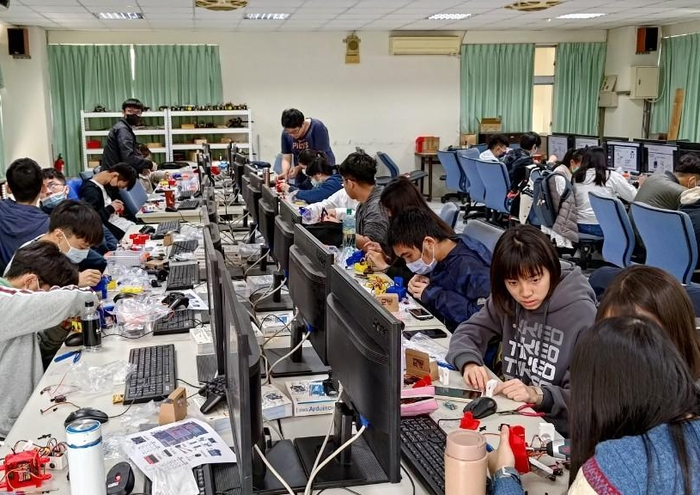Robotic System Integration for Improving Learning Outcomes in the Graduation Project Capstone Course
In this work, we use the robotic system integration to improve students’ learning outcomes in the Graduation Project course that is the Capstone Course in our department. The Capstone Course provides the opportunities for undergraduate students to integrate, to closure, and to reflect the learning experiences in the university. During the guidance in recent years, we find two major challenges: how to teach the system integration capability to students, and how to attract students’ interest to the graduation project.
To overcome the first challenge, we invite industrial experts to join the teaching and learning in this work. Students learn the system integration methods adopted in the industry, so that the gap between industry and academia could be shorten. We invite four industrial experts in robotics to hold short courses and hands-on workshops, so that students could learn the professional skills and valuable experience from these experts.
Moreover, to overcome the second challenge, we choose the robotic system integration as the goal of the graduation project. We use this interesting and explicit goal with moderate difficulty to attract students. The gamification technique is used to attract students’ interest in the graduation project. We use the questionnaires and the Octalysis Framework for gamification to analyze the core drives that motivate the students to accomplish their robotics graduation projects.
Our analytical results show that the gamification by using the robotic system integration as the goal of the graduation project could effectively use several core drives in the Octalysis gamification framework to improve students’ motivation. The unpredictability, the accomplishment, and the empowerment are the three most important core drives.
SANPO Robot: Make Your Own Biped Humanoid Robot with Low Entry Barrier
Biped Humanoid robots are interesting to motivate students to learn interdisciplinary knowledge and skills of engineering and computer science. Most humanoid robots available in the market are so expensive that students cannot afford the cost. Moreover, those robots are usually limited to built-in functionalities. Students have great difficulty to modify or extend the hardware/software functionalities of those robots, if possible. There exist some projects that can help students build their own robots at low cost. However, students or teachers need to 3D-print the robot parts so that they can start to build the robots. 3D printing is time-consuming and possibly unstable, so preparing the 3D-printed robot parts would be a challenging task, even for tens of students.
In this work, we design the SANPO robot for educational purpose with low entry barrier. The SANPO robot has six degrees of freedom with two legs and two arms. We design the robot shell components by using the open-source FreeCAD software. Students could easily modify the design if they want. Teachers and students could easily prepare the parts of this robot by using laser cut machines with acrylic sheets or medium density fiberboards. The SANPO robot is easy to build with off-the-shelf electronic components such as Arduino, servo motors, and ultrasonic modules which are all cheap and popular in the market. The robot could be programmed with GUI-based and instruction-based development environments. The design is easy to modify and extend with other modules and functionalities, such as Bluetooth, infra-red, buttons, AI camera, and smartphone applications. We also design the relevant course about assembling and programming the robot.
We have used the SANPO robot to teach more than 160 people, including students and teachers. All of them successfully built and programmed their own robots. They also successfully modified the hardware and software, so that their own robots could perform various walk and dance actions, make various sounds and music, and perform various interesting tasks such as playing soccer, fighting with other robots, and walking out of a maze autonomously.

